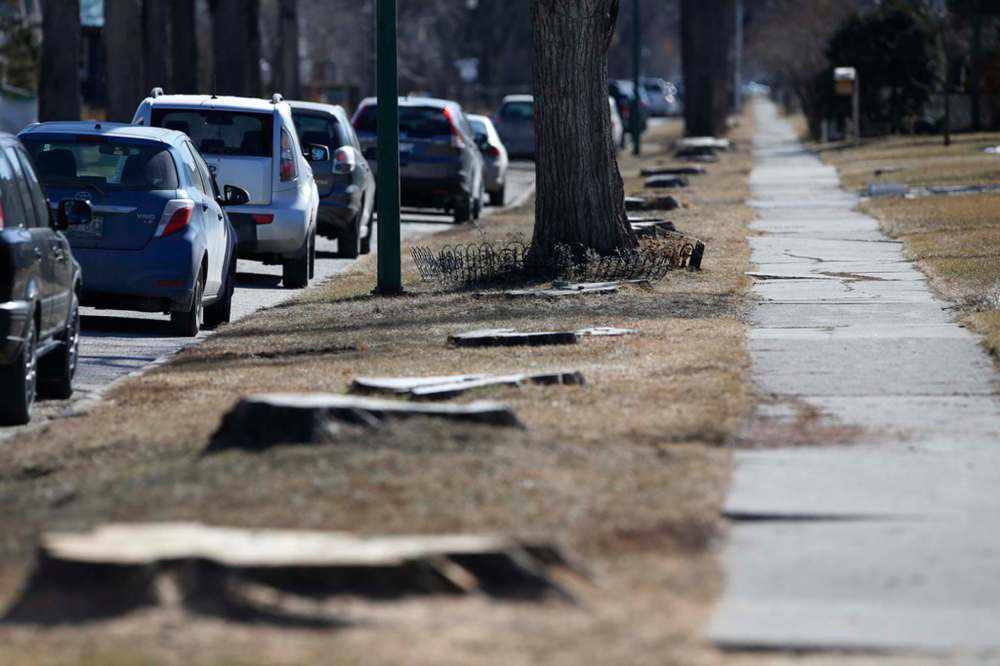City residents left in a slump, as they look at the stumps
Advertisement
Read this article for free:
or
Already have an account? Log in here »
To continue reading, please subscribe:
Monthly Digital Subscription
$0 for the first 4 weeks*
- Enjoy unlimited reading on winnipegfreepress.com
- Read the E-Edition, our digital replica newspaper
- Access News Break, our award-winning app
- Play interactive puzzles
*No charge for 4 weeks then price increases to the regular rate of $19.00 plus GST every four weeks. Offer available to new and qualified returning subscribers only. Cancel any time.
Monthly Digital Subscription
$4.75/week*
- Enjoy unlimited reading on winnipegfreepress.com
- Read the E-Edition, our digital replica newspaper
- Access News Break, our award-winning app
- Play interactive puzzles
*Billed as $19 plus GST every four weeks. Cancel any time.
To continue reading, please subscribe:
Add Free Press access to your Brandon Sun subscription for only an additional
$1 for the first 4 weeks*
*Your next subscription payment will increase by $1.00 and you will be charged $16.99 plus GST for four weeks. After four weeks, your payment will increase to $23.99 plus GST every four weeks.
Read unlimited articles for free today:
or
Already have an account? Log in here »
Hey there, time traveller!
This article was published 19/03/2021 (1725 days ago), so information in it may no longer be current.
LINDA OBIREK moved to Sherburn Street with her husband 30 years ago for a few reasons, but one hits a sore spot for her now.
“I bought my house because of the trees,” she says.
The lush elm canopy that once graced the neighbourhood is gone now: a result of Dutch elm disease tearing through the area.

Obirek said at least three-quarters of the trees three decades prior have been stripped away, and many of them have been removed by the City of Winnipeg in the last few days.
“I almost want to move now. This street is just not the same. Being a senior, by the time they grow back, I’ll probably be dead.”
Obirek said, on her side of the street, there were five trees remaining; the other side had been stripped bare.
According to a city spokesperson, there were some 8,000 American elm trees marked for removal through Winnipeg’s 2020 Dutch elm disease surveillance program, and around 80 per cent have already been cut down.
There are also around 2,700 ash trees marked for removal around city boulevards, due to cottony ash psyllid and other harmful factors.
Out of the 8,000 elm trees, 6,540 were or are diseased, while the rest are either dead or categorized as a hazard “due to a high probability that the elm bark beetle uses these trees to produce a new generation of beetles hence contributing to the population of beetles,” the city said.
Winnipeg’s urban forestry branch is planning to plant around 2,800 replacement trees in 2021 on boulevards and in parks, beginning in May.
Obirek’s street is part of the Daniel McIntyre neighbourhood, which is set to receive $300,000 from the city’s land dedication reserve, after a motion from Coun. Cindy Gilroy to redirect the funding, typically used for property acquisition or development, to tree planting was passed.
“Here in the inner city, in the urban area, we don’t have access to some of the beautiful trails that they have in more of the suburban neighbourhoods,” Gilroy said. “When we go for a walk, we’re using our streets.
“Our urban canopy is our forest, it’s the place where we go and walk, and it’s where we see the birds and all the animals and something that we really treasure.”
The funding will be used to plant and maintain the early stages of around 400 trees over a two-year process.
Gilroy said she plans to set up a program where constituents can check in and let her office know where they’d like to see more trees.
“We’re seeing a devastating amount of trees being lost, and it really does impact the area,” she said.
Maintaining healthy and full foliage should be recognized as an important aspect of fighting climate change in the city — both as a way to capture and store carbon dioxide and as an energy saver for urban spaces, she said.
“There’s lots of different positive aspects of having trees.”
malak.abas@freepress.mb.ca
Twitter: malakabas_

Our newsroom depends on a growing audience of readers to power our journalism. If you are not a paid reader, please consider becoming a subscriber.
Our newsroom depends on its audience of readers to power our journalism. Thank you for your support.





